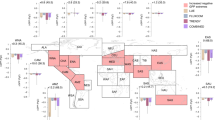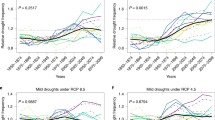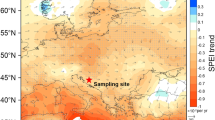Abstract
Fossil fuel emissions aside, temperate North America is a net sink of carbon dioxide at present1,2,3. Year-to-year variations in this carbon sink are linked to variations in hydroclimate that affect net ecosystem productivity3,4. The severity and incidence of climatic extremes, including drought, have increased as a result of climate warming5,6,7,8. Here, we examine the effect of the turn of the century drought in western North America on carbon uptake in the region, using reanalysis data, remote sensing observations and data from global monitoring networks. We show that the area-integrated strength of the western North American carbon sink declined by 30–298 Tg C yr−1 during the 2000–2004 drought. We further document a pronounced drying of the terrestrial biosphere during this period, together with a reduction in river discharge and a loss of cropland productivity. We compare our findings with previous palaeoclimate reconstructions7 and show that the last drought of this magnitude occurred more than 800 years ago. Based on projected changes in precipitation and drought severity, we estimate that the present mid-latitude carbon sink of 177–623 Tg C yr−1 in western North America could disappear by the end of the century.
This is a preview of subscription content, access via your institution
Access options
Subscribe to this journal
Receive 12 print issues and online access
$259.00 per year
only $21.58 per issue
Buy this article
- Purchase on Springer Link
- Instant access to full article PDF
Prices may be subject to local taxes which are calculated during checkout




Similar content being viewed by others
References
Nemani, R. R. et al. Recent trends in hydrological balance have enhanced the terrestrial carbon sink in the United States. Geophys. Res. Lett. 29, 1468 (2002).
Potter, C. S. et al. Estimating carbon budgets for US ecosystems. Eos 87, 85–96 (2006).
Xiao, J. et al. Assessing net ecosystem carbon exchange of US terrestrial ecosystems by integrating eddy covariance flux measurements and satellite observations. Agric. For. Meteorol. 151, 60–69 (2011).
Schwalm, C. R., Williams, C. A. & Schaefer, K. M. Carbon consequences of global hydrologic change, 1948–2009. J. Geophys. Res. 116, G03042 (2011).
Bates, B. C., Kundzewicz, Z. W., Wu, S. & Palutikof, J. P. (eds) Climate Change and Water. Technical Paper of the Intergovernmental Panel on Climate Change (IPCC Secretariat, 2008).
Huntington, T. G. Evidence for intensification of the global water cycle: Review and synthesis. J. Hydrol. 319, 83–95 (2006).
Cook, E. R., Woodhouse, C. A., Eakin, C. M., Meko, D. M. & Stahle, D. W. Long term aridity changes in the western United States. Science 306, 1015–1018 (2004).
Dai, A., Trenberth, K. E. & Qian, T. A global data set of Palmer Drought Severity Index for 1870–2002: Relationship with soil moisture and effects of surface warming. J. Hydrometerol. 5, 1117–1130 (2004).
Lobell, D. B. et al. Satellite estimates of productivity and light use efficiency in United States agriculture, 1982–1998. Glob. Change Biol. 8, 1–15 (2002).
Misson, L., Tang, J., Xu, M., McKay, M. & Goldstein, A. Influences of recovery from clear-cut, climate variability, and thinning on the carbon balance of a young ponderosa pine plantation. Agric. For. Meteorol. 130, 207–222 (2005).
Breshears, D. D., López-Hoffman, L. & Graumlich, L. J. When ecosystem services crash: preparing for big, fast, patchy climate change. Ambio 40, 256–263 (2011).
Schwalm, C. R. et al. Assimilation exceeds respiration sensitivity to drought: A FLUXNET synthesis. Glob. Change Biol. 16, 657–670 (2010).
Hibbard, K. A., Law, B. E., Reichstein, M. & Sulzman, J. An analysis of soil respiration across northern hemisphere temperate ecosystems. Biogeochemistry 73, 29–70 (2005).
Scott, R. L., Huxman, T. E., Williams, D. & Goodrich, D. C. Ecohydrological impacts of woody-plant encroachment: Seasonal patterns of water and carbon dioxide exchange within a semiarid riparian environment. Glob. Change Biol. 12, 311–324 (2006).
Wang, S. & Davidson, A. Impact of climate variations on surface albedo of a temperate grassland. Agr. Forest Meteorol. 142, 133–142 (2007).
Alley, W. M. Palmer drought severity index: Limitations and assumptions. J. Clim. Appl. Meteorol. 23, 1100–1109 (1984).
Cook, E. R. et al. Megadroughts in North America: placing IPCC projections of hydroclimatic change in a long-term palaeoclimate context. J. Quat. Sci. 25, 48–61 (2010).
Woodhouse, C. A., Meko, D. M., MacDonald, G. M., Stahle, D. W. & Cook, E. R. A 1,200-year perspective of 21st century drought in southwestern North America. Proc. Natl Acad. Sci. USA 107, 21283–21288 (2010).
Stahle, D. W., Fye, F. K., Cook, E. R. & Griffin, R. D. Tree-ring reconstructed megadroughts over North America since AD 1300. Climatic Change 83, 133–149 (2007).
Mote, P. W., Hamlet, A. F., Clark, M. P. & Lettenmaier, D. P. Declining mountain snowpack in western North America. Bull. Am. Meteorol. Soc. 86, 39–49 (2005).
Pederson, G. T. et al. The unusual nature of recent snowpack declines in the North American Cordillera. Science 333, 332–335 (2011).
Seager, R. et al. Model projections of an imminent transition to a more arid climate in southwestern North America. Science 316, 1181–1184 (2007).
Burke, E. J., Brown, S. J. & Christidis, N. Modeling the recent evolution of global drought and projections for the twenty-first century with the Hadley centre climate model. J. Hydrometeorol. 7, 1113–1125 (2006).
Wehner, M. F. et al. Projections of future drought in the Continental United States and Mexico. J. Hydrometeorol. 12, 1359–1377 (2011).
Meehl, G. A. et al. The WCRP CMIP3 multi-model dataset: A new era in climate change research. Bull. Amer. Meteorol. Soc. 88, 1383–1394 (2007).
Zhao, M. & Running, S. W. Drought-Induced reduction in global terrestrial net primary production from 2000 through 2009. Science 329, 940–943 (2010).
Bosilovich, M., Chen, J., Robertson, F. R. & Adler, Evaluation of global precipitation in reanalyses. J. Appl. Meteorol. Climatol. 47, 2279–2299 (2008).
Hicke, J. A., Lobell, D. B. & Asner, G. P. Cropland area and net primary production computed from 30 Years of USDA agricultural harvest data. Earth Interact. 8, 1–20 (2004).
Jung, M. et al. Global patterns of land-atmosphere fluxes of carbon dioxide, latent heat, and sensible heat derived from eddy covariance, satellite, and meteorological observations. J. Geophys. Res. 116, G00J07 (2011).
Taylor, K. E., Stouffer, R. J. & Meehl, G. A. An overview of CMIP5 and the experiment design. Bull. Amer. Meteorol. Soc. 90, 1467–1485 (2011).
Acknowledgements
C.R.S., C.A.W. and K.S. were supported by the US National Science Foundation grant ATM-0910766. C.A.W. was additionally supported through NASA Terrestrial Ecology award NNX10AR68G (2N041). B.E.L. was supported by AmeriFlux (the Office of Science (BER), US Department of Energy (DE-FG02-04ER63917 and DE-FG02-04ER63911)). K.T.P.U. was supported by the US National Science Foundation grant F1137306/MIT subaward 5710003122 to the University of California, Davis. We acknowledge the World Climate Research Programme’s Working Group on Coupled Modelling, which is responsible for CMIP, and we thank the climate modelling groups (Supplementary Table S4) for producing and making available their model output. For CMIP the US Department of Energy’s Program for Climate Model Diagnosis and Intercomparison provided coordinating support and led development of software infrastructure in partnership with the Global Organization for Earth System Science Portals. CarbonTracker 2011 results provided by NOAA ESRL, Boulder, Colorado, USA from the website at http://carbontracker.noaa.gov. Jena CO2 inversion results provided courtesy of C. Rödenbeck, Max Planck Institute for Biogeochemistry, Jena, Germany.
Author information
Authors and Affiliations
Contributions
C.R.S., C.A.W. and K.S. designed the study and are responsible for the integrity of the manuscript; C.R.S. carried out the analysis and all calculations. C.R.S., with C.A.W. and K.S., wrote the manuscript. D.B., T.A.B., A.H.G., B.E.L., W.C.O., K.T.P.U. and R.L.S. contributed FLUXNET data. All authors discussed and commented on the manuscript.
Corresponding author
Ethics declarations
Competing interests
The authors declare no competing financial interests.
Supplementary information
Supplementary Information
Supplementary Information (PDF 947 kb)
Rights and permissions
About this article
Cite this article
Schwalm, C., Williams, C., Schaefer, K. et al. Reduction in carbon uptake during turn of the century drought in western North America. Nature Geosci 5, 551–556 (2012). https://doi.org/10.1038/ngeo1529
Received:
Accepted:
Published:
Issue Date:
DOI: https://doi.org/10.1038/ngeo1529
This article is cited by
-
A joint framework for studying compound ecoclimatic events
Nature Reviews Earth & Environment (2023)
-
Uncertainty in US forest carbon storage potential due to climate risks
Nature Geoscience (2023)
-
Drought Timing Modulates Soil Moisture Thresholds for CO2 Fluxes and Vegetation Responses in an Experimental Alpine Grassland
Ecosystems (2023)
-
Impacts of Extreme Droughts on Ecosystem Water Use Efficiency Diverge between Forest and Grassland
Journal of Meteorological Research (2023)
-
Heat and drought impact on carbon exchange in an age-sequence of temperate pine forests
Ecological Processes (2022)



